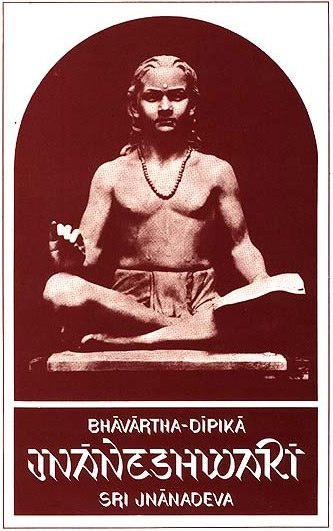Jnaneshwari (Bhavartha Dipika)
by Ramchandra Keshav Bhagwat | 1954 | 284,137 words | ISBN-10: 8185208123 | ISBN-13: 9788185208121
This is verse 8.18-19 of the Jnaneshwari (Bhavartha-Dipika), the English translation of 13th-century Marathi commentary on the Bhagavad-Gita.—The Dnyaneshwari (Jnaneshwari) brings to light the deeper meaning of the Gita which represents the essence of the Vedic Religion. This is verse 18-19 of the chapter called Akshara-brahman-yoga.
Verse 8.18-19
Verse 8.18: “From the Non-manifest all Manifestations spring forth at the advent of the Day; at the advent of the Night they get dissolved into that very same (entity) known as the Nonmanifest.
Verse 8.19: “The self-same aggregate of beings, after repeatedly coming into existence, gets dissolved, in utter helplessness, at the advent of the Night, O Son of Pritha, and springs into being at the advent of the Day. (160)
Commentary called Jnaneshwari by Jnaneshwar:
At the dawn of the day in the time cycle of Brahma the non-manifest being becomes manifest as the visible universe of countless things. At the end of twelve hours of the day, this ocean of countless things ebbs away and again at the dawn it swells in high tide. The clouds melt into the sky at the coming of the ‘Sharad [Sharada]’ season (about the month of November), and again take shape at the end of ‘Grishma’ season (about the months of July-August); in the same way, at the beginning of the day time of the creator God, this universe, comes into being by the stuff of the five gross elements, and endures as long as the completion of the thousand rounds of the four aeon cycle. Then with the approach of the night, the universe is dissolved into the nonmanifest (spirit of the Supreme Brahman).
The night of Brahmadev [Brahmadeva] (also) lasts till the completion of thousand rounds of the four aeon cycle, and when these rounds are completed the universe gets recreated as before. This long winded story shows that the cycle of creation and dissolution alternates during one day and one night of the duration of the God Brahmadeva. Just see, the measure of this life span of Brahmadeva is so wide, that it holds in itself the storehouse of the seed of the entire universe: yet in the measure (māpaḍe) of the rounds of the cycle of birth and death, this life span of Brahmadeva becomes only the last pulse that completes that endless measure. This entire mass of the created worlds, Oh Dhanurdhara, is only the outlying environs of the city of Brahma. It springs up at the dawn and at the advent of the night it disappears, i.e. gets merged into its original seed, the state of evenness—(sāmya). Just as a ‘tree-state’ extinguishes in the seed in the end, or just as the clouds eventually become dissolved into the sky, in that way, the state into which are merged the manifold becoming of all things, is called Samya (sāmya—the state of unitary being).
